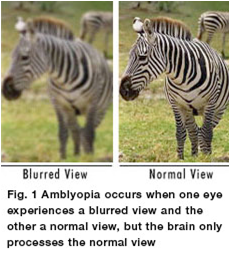Lazy Eye
Amblyopia
Most people have very different understandings or ideas surrounding the term lazy eye or amblyopia. Amblyopia is defined as the loss, or lack of, development of central vision in one eye that is unrelated to any eye health problem and is not correctable with lenses.
 Many believe an eye turning in or out (strabismus) is a lazy eye or believe their non-dominant eye is a lazy eye. Patients often have their own definition of what an amblyopic (lazy) eye is to them. Eye turning, astigmatism, anisometropia, cataracts, and several other issues potentially deprive an eye from developing proper vision.
Many believe an eye turning in or out (strabismus) is a lazy eye or believe their non-dominant eye is a lazy eye. Patients often have their own definition of what an amblyopic (lazy) eye is to them. Eye turning, astigmatism, anisometropia, cataracts, and several other issues potentially deprive an eye from developing proper vision.
There are many treatments available, but the critical component to treating lazy eye is detecting an amblyopia before it becomes uncorrectable. A high percentage of amblyopic patients have a normal cosmetic appearance (no eye turning) and are not discovered early on, because the other eye demonstrates normal function. If the amblyopic eye is being suppressed by any of the early mentioned factors, it will be deprived the development required for stereoscopic depth perception (3-D Vision).

This is often how amblyopia looks.
Amblyopia (Lazy Eye) can be determined at a young age and early intervention is key to enhancing vision and performance. (Visit our Pediatrics page if you have questions surrounding children’s eye health.)
More information on amblyopia
American Association for Pediatric Ophthalmology and Strabismus

